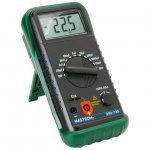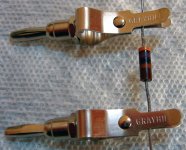I built one of these a couple of years ago and have found it very useful for measuring and matching caps accurately:
High-res Cap meter by RomanBlack
Thanks!
If I need to work out a capacitor value.
I put it in parallel with an known inductor and in series with a resistor.
I apply a sine wave until I get a minimum across LC and thats the resonant frequency.
f=1/(2 pi root(LC))
Clearly only as accurate as the inductor.
I put it in parallel with an known inductor and in series with a resistor.
I apply a sine wave until I get a minimum across LC and thats the resonant frequency.
f=1/(2 pi root(LC))
Clearly only as accurate as the inductor.
Same room temperature and humidity? Have the parts been moved or being held differently? Or did you use clip wires on the probe ends and then not touch the setup other than turn the meter off and on. SO tomorrow, you can carefully turn the meter back on without budging anything else from the day before
I agree that this can vary from day to day. For matching, that doesn't matter - just measure the various parts in quick succession, within a minute or so. Meter variations at short term are much less.
You can check it by measuring the same part in quick succession. If you read the same value within less than a minute, you're all set!
Jan
My Fluke 87 (in relative mode) let me down, or so I think it has. Every day I measure the values go up and down a little -- inconsistent. Is it temperature related or what?
I see the same effect with my multymeter (not Fluke), that's why I use it only to compare two caps at the same time. For precision measurement I use professional RLC-meter (Mastech 5308).
Last edited:
Something I decided to test out is the KKmoon M6013 Capacitor Meter from Amazon for 40 bucks:
https://www.amazon.com/gp/product/B077JMYW6K/ref=ppx_yo_dt_b_asin_title_o01_s00?ie=UTF8&psc=1
I will only be able to compare to my Fluke 87 but will post my results in a few days. The Mastech 5308 is much too pricey for my needs.
https://www.amazon.com/gp/product/B077JMYW6K/ref=ppx_yo_dt_b_asin_title_o01_s00?ie=UTF8&psc=1
I will only be able to compare to my Fluke 87 but will post my results in a few days. The Mastech 5308 is much too pricey for my needs.
The Aneng 8009 may be cheaper, and has been quite accurate for me. Plus it provides so much more 🙂
On my fluke 87 it shows similar on smaller caps. Its lower limit seems to be around 1 nF and the residual is really sensitive to the leads. I know from experiece that the leads add > 100 pF, not the 360-450 pF the meter is indicating. I would not use it for anything beyond testing motor caps for failure.
The meter kit you reference looks quite good and a value for the price.
This looks like it could do similar for a very reasonable price: https://www.amazon.com/DollaTek-Poc...4662698&s=electronics&sr=1-11#customerReviews or any of the 10 clones on Amazon. Get it from Amazon because returns are not a problem if its not right.
For a preamp eq. you really need accurate caps. Polystyrene preferably. And metal film resistors. The resistors are easy. PS caps are made to 2.5% and then selected to 1%. You get to pay for the ones that meet spec and all the ones that did not. You can use COG ceramic caps which can also be made to 1% and are similarly stable and low distortion, However useful values will be large and expensive in COG.
The meter kit you reference looks quite good and a value for the price.
This looks like it could do similar for a very reasonable price: https://www.amazon.com/DollaTek-Poc...4662698&s=electronics&sr=1-11#customerReviews or any of the 10 clones on Amazon. Get it from Amazon because returns are not a problem if its not right.
For a preamp eq. you really need accurate caps. Polystyrene preferably. And metal film resistors. The resistors are easy. PS caps are made to 2.5% and then selected to 1%. You get to pay for the ones that meet spec and all the ones that did not. You can use COG ceramic caps which can also be made to 1% and are similarly stable and low distortion, However useful values will be large and expensive in COG.
Just saw this on Amazon: https://www.amazon.com/dp/B08P47KZT...uPWNsaWNrUmVkaXJlY3QmZG9Ob3RMb2dDbGljaz10cnVl Price is right.
- Home
- Design & Build
- Equipment & Tools
- Measuring low capacitance accurately

